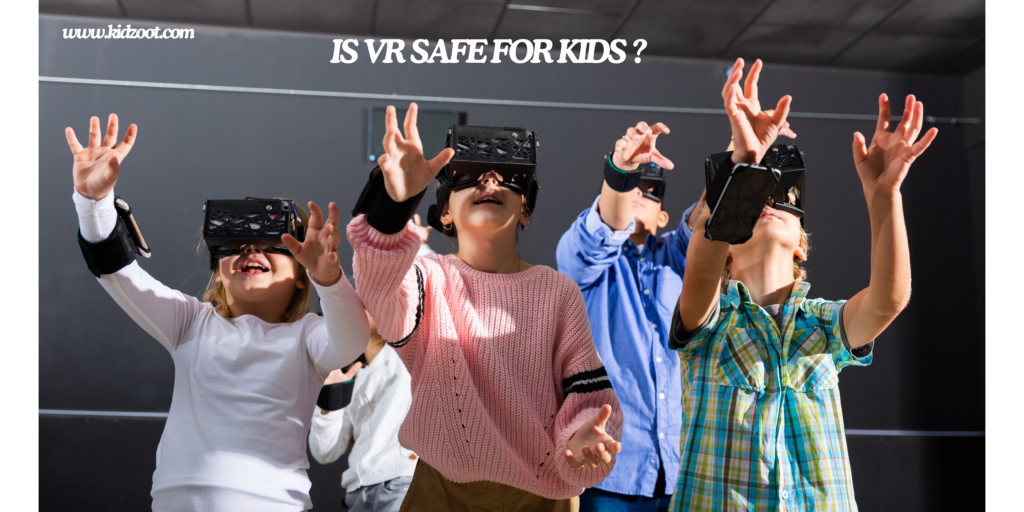- Updated on 25 July, 2024
Are Virtual Reality Headsets Safe for Children?
The rapid proliferation of virtual reality (VR) technology has sparked both excitement and concern, particularly regarding its use by children. As VR headsets become increasingly popular and accessible, it’s crucial to examine their potential impacts on young users’ health and development. This article delves into the current understanding of VR’s effects on children, drawing from available research and expert opinions to provide a comprehensive overview for parents, educators, and healthcare professionals.
Age Restrictions and Manufacturer Recommendations
Many leading VR device manufacturers have implemented age restrictions for their products:
– Oculus Rift and Samsung’s Gear VR recommend their devices for users aged 13 and above.
– Sony’s PlayStation VR suggests a minimum age of 12 for users.
– HTC’s Vive explicitly advises against use by young children.
– Google Cardboard recommends adult supervision for child users.
These restrictions often come without detailed explanations, leaving consumers to question the reasoning behind these age limits.
Potential Effects on Brain Development
The impact of VR on developing brains is a primary concern, yet research in this area remains limited. A 2014 study conducted on rats at the University of California found that neurons in a brain region associated with spatial learning behaved differently in virtual environments compared to real ones. Notably, more than half of these neurons shut down while in VR. While we cannot directly extrapolate these findings to humans, they underscore the need for more comprehensive research on VR’s long-term effects, especially on children’s developing brains.
Marientina Gotsis, director of the Creative Media & Behavioral Health Center at the University of Southern California School of Cinematic Arts, emphasizes the potential impact on children’s neuroplasticity. The brain’s high plasticity during childhood means that prolonged exposure to improperly fitted VR devices could potentially incur damage. Moreover, children may struggle to articulate discomfort or eyestrain and may lack the reflexes to remove uncomfortable devices.

Is VR Safe for Children with ADHD?
Virtual reality (VR) technology has shown promise as a potential tool for helping children with Attention Deficit Hyperactivity Disorder (ADHD), but its safety and effectiveness require careful consideration. While VR can offer engaging, immersive experiences that may capture and maintain the attention of children with ADHD, there are both potential benefits and risks to consider.
On the positive side, VR environments can provide structured, controlled settings for ADHD children to practice focus, impulse control, and social skills. Some studies have shown that VR-based interventions can improve attention span and reduce hyperactivity symptoms in controlled settings. The immersive nature of VR may help minimize external distractions, allowing ADHD children to concentrate more effectively on specific tasks or learning objectives.
However, the same immersive qualities that make VR potentially beneficial also raise concerns. Children with ADHD may be more susceptible to the vergence-accommodation conflict and other visual discomforts associated with VR use, potentially exacerbating attention issues or causing physical discomfort. The intense sensory stimulation of VR environments might also be overwhelming for some ADHD children, leading to overstimulation or increased agitation.
Additionally, there’s a risk that excessive VR use could interfere with the development of real-world social skills and coping mechanisms that are crucial for ADHD management. The addictive potential of VR experiences is also a concern, as children with ADHD may struggle with impulse control and setting healthy boundaries with technology use.
Given these considerations, the use of VR for children with ADHD should be approached cautiously and under professional guidance. Short, supervised sessions with content specifically designed for ADHD intervention may be beneficial, but should be balanced with other therapeutic approaches and real-world skill development. As research in this area is still emerging, parents and healthcare providers should stay informed about the latest findings and recommendations to ensure the safe and effective use of VR technology for children with ADHD.
Vision Concerns and the Vergence-Accommodation Conflict
One of the most significant concerns regarding VR use in children revolves around its potential impact on vision development. While the American Academy of Ophthalmology states that there’s no evidence of permanent damage from long-term screen exposure, VR presents unique challenges due to its immersive nature.
A key issue is the vergence-accommodation conflict. In natural viewing, our eyes converge (point towards) and accommodate (focus) on objects at the same distance. However, in VR:
1. The eyes converge on virtual objects at varying perceived distances.
2. The lenses must remain focused on the fixed screen distance.
This disconnect between vergence and accommodation can lead to visual discomfort, eyestrain, and potentially impact the development of the visual system in children.
Peter Howarth, an optometrist and senior lecturer in visual ergonomics at Loughborough University, suggests that while this conflict might cause discomfort, it could also help identify existing vision problems in children. He notes that those with already weak eye movement and control are more likely to experience adverse effects like headaches and eyestrain when using VR.
Psychological and Social Considerations
Michael Madary, a postdoctoral research assistant at the University of Mainz, highlights several psychological concerns:
1. Reality-Fiction Distinction: Young children often struggle to differentiate between reality and fantasy. Immersive VR experiences could exacerbate this difficulty.
2. Enhanced Impact of Content: Experiences that might be traumatic when viewed on a traditional screen could have an even more significant impact in VR due to its immersive nature.
3. Manipulation Risks: VR environments are entirely designed, potentially allowing for sophisticated manipulation of users. This could be particularly concerning for children, who may be more susceptible to advertising or other forms of influence.
4. Autonomy and Development: Extended immersion in VR environments during crucial developmental stages could influence a child’s autonomy and shape their worldview in unforeseen ways.
Physical Concerns: Cybersickness and Ergonomics
Physical discomfort associated with VR use, often termed “cybersickness,” is another area of concern. Symptoms can include headaches, dizziness, nausea, and disorientation. These symptoms result from the discrepancy between the visual information provided by the VR headset and the body’s sense of movement and position.
Additionally, the weight of VR headsets, averaging around 1.5 pounds for popular models, poses ergonomic concerns. Dr. Nathan Cheung, a pediatric optometrist at Duke University, identifies neck strain as an immediate risk for children using VR headsets.
Research and Recommendations from Health Organizations
The French Agency for Food, Environmental and Occupational Health & Safety (ANSES) conducted a comprehensive study on the potential health risks related to 3D audiovisual technologies, including VR. Their recommendations include:
1. Children under six should not be exposed to 3D technologies, including VR.
2. Children under 13 should use 3D technologies, including VR, only in moderation.
3. Parents and children should be vigilant about any symptoms resulting from VR use.
4. Individuals with certain visual disorders or balance problems should limit their exposure to these technologies.
Potential Benefits and Educational Applications
While concerns about VR use in children are valid, it’s important to acknowledge the technology’s potential benefits, particularly in educational settings. VR can offer immersive learning experiences that may enhance understanding and retention of complex concepts, such as virtual field trips, interactive 3D models for studying anatomy or chemistry, and simulations for practical skills training in safe environments.

Guidelines for Safe VR Use by Children
Given the current state of research and expert recommendations, the following guidelines can help ensure safer VR experiences for children:
1. Adhere to manufacturer age recommendations and avoid VR use for children under 6.
2. Set strict time limits for VR sessions, with experts suggesting no more than 15-20 minutes at a time for younger children.
3. Carefully vet VR content to ensure it’s age-appropriate.
4. Ensure a safe physical environment for VR use, free from obstacles or hazards.
5. Make sure the VR headset fits correctly and comfortably.
6. Encourage frequent breaks and implement the 20-20-20 rule.
7. Watch for signs of discomfort, eyestrain, dizziness, or changes in behavior.
8. Ensure VR use doesn’t replace important real-world experiences and physical activities.
9. Encourage children to express any discomfort or unusual experiences during or after VR use.
10. Schedule regular eye examinations to monitor for any changes in vision or eye health.
Myopia and Screen Time
The World Health Organization warns that by 2030, 40% of the world’s population will be nearsighted. In the U.S. alone, myopia rates have soared from 25% in 1971 to nearly 42% in 2017. Many of these myopia cases are in children, who are going nearsighted at increasingly younger ages. In China, over 80% of teens and young adults are now nearsighted.
Experts agree that this increase in myopia is related to how children spend their time – too little time outside and too much time indoors, often staring at screens. For a young child whose eyes are still developing, these habits cause their eyes to prioritize near vision rather than distance vision, potentially triggering nearsightedness.
Dr. Maria Liu, an associate professor of clinical optometry at The University of California, Berkeley, notes that children as young as four or five years old are becoming myopic. Early onset myopia can lead to dangerous vision problems later in life, including retinal detachment, glaucoma, cataracts, and even complete loss of vision.
To prevent myopia in children, Dr. Liu recommends limiting screen time and encouraging outdoor play. For adults, she suggests taking regular outdoor breaks to scan the horizon for 3-5 minutes to exercise distance vision, especially after prolonged near work.
Recent Developments in VR Safety Research
A recent study published in the Journal of the American Medical Association (JAMA) Ophthalmology provides some reassuring data on the short-term effects of VR use in children. The study, conducted with 50 children aged 4-10 years, found that a majority of participants (94%) completed two 30-minute VR play sessions without significant changes in visual acuity, stereoacuity, or balance.
However, the study did note a slight increase in symptoms such as eye discomfort, headache, and motion sickness. While these findings are encouraging, the researchers emphasize the need for further studies on long-term effects and potential impacts on visual development.
Conclusion
The impact of VR technology on children’s health and development remains a complex and evolving field of study. While VR offers exciting possibilities for education and entertainment, the potential risks cannot be ignored. The lack of long-term studies on VR’s effects on developing brains and visual systems calls for a cautious approach.
Parents, educators, and healthcare professionals must stay informed about the latest research and recommendations. As we await more comprehensive studies, moderation, careful supervision, and adherence to safety guidelines are crucial in ensuring that children’s experiences with VR technology are as safe and beneficial as possible.
Ultimately, VR should be viewed as a tool that, when used responsibly, can enhance learning and provide new experiences. However, it should not replace the rich, multisensory experiences of the real world that are essential for healthy child development. As VR technology continues to advance, ongoing research and open dialogue between technology developers, health professionals, and users will be vital in shaping safe and effective use policies for children.
REFERENCES-
https://eye.hms.harvard.edu/news/prescribing-virtual-reality-device-treat-children-amblyopia
https://www.npr.org/2023/10/17/1200611635/the-story-behind-soaring-myopia-among-children
https://www.anses.fr/en/content/3d-technologies-and-eyesight-use-not-recommended-children-under-age-six-use-moderation-0
https://www.sciencedirect.com/science/article/abs/pii/S0002939419303812

Abhishek Sonkar
Meet Abhishek Sonkar, [B.com, B.Ed., M.Ed.], a child development specialist with years of experience in the field. He has written numerous blog posts on child development and parenting.

